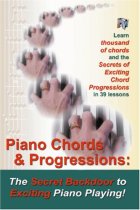How To Straddle a 7th Chord On The Piano
Some Ways To Manipulate a 7th Chord On The Piano Keyboard
| Good morning. This is Duane, and today I’d like to talk about how to straddle a 7th chord on the piano. |
| First, let me define what a 7th chord is, and I’m sure you know this, but it’s any kind of triad with the 7th degree of the scale with it. That’s a C major 7th, that’s a C 7th, but it’s still a 7th chord. There’s different kinds of 7th chords. There’s major 7th chords and dominant 7th chords, and minor 7th chords and so on, but the principle’s the same. A 7th chord is the 7th degree of the scale, or the altered 7th degree of the scale, such as a flat 7th. A straddle is where you play two of the four notes, so in those four notes in a 7th chord, obviously, one, two, three, four. If you straddle one while playing two, so you play two, and you’re straddling that one, and then you play the other two, that’s a straddle right there.
|
| If you’re new to straddling, that can be a little intimidating. It may take a little practice. It might take a lot of practice, matter of fact, to get that down to where you feel comfortable with it, but it’s worth pursuing because you can get a really nice sound with it.
|
| That kind of feel. Let’s take it slowly. Play the top note and the second note from the bottom, and then the bottom note and the middle note, and you can do that with any 7th chord at all. You can do it with other chords too, but let’s just focus on 7th chords right now. If I do it on D minor 7th, same principle, E minor 7th. It doesn’t have to be a minor 7th, by the way. You can have a dominant 7th, or a C minor 7th. E flat 7th, E flat minor 7th.
|
| That’s a D flat 9th. You can do it with 9th chords as well. For example, that’s C major 7th, but that’s C major 9th, that is, if you’re playing the root on the left hand, so you can straddle that.
|
| Of course, you can do it in all kind of rhythm. It doesn’t have to be a smooth rhythm like that. It could be … Depends what kind of music you’re playing. Notice I’m sliding off one of the notes there as I play.
|
| You can slide off any one of the notes. Usually with my index finger it’s a little easier than with any other note, but you can do it with other notes as well.
|
| Okay, that’s a 7th straddle. Now, I said you could do it to other chords as well. For example, let’s say I want to play an E flat, well that would be a 7th chord too. I was thinking, you could play … That’s an E flat major 7th. That’s just the same thing as we did, except it’s inverted, turned upside down.
|
| Any chord, let’s take C6, same principle, so you can do it to any chord that has four notes, obviously.
|
| Okay, that’s it for today. Hope that’s helpful to you. It’s a technique you can plug in to lots and lots of different songs and situations. If you enjoy this kind of thing, come on over to playpiano.com and sign up for our series of videos and newsletters on chords and chord progressions. I think you’ll like what you see there, so hope to see you there. Bye bye for now. |
Click on this link to watch this video on YouTube: https://www.youtube.com/watch?v=NC51YKtbs8U&feature=youtu.be
***For lots more good stuff on piano playing come on over to my website at https://www.playpiano.com and sign up for our free piano tips – “Exciting Piano Chords & Sizzling Chord Progressions!”
Here’s a great little book on chords and chord progressions on Amazon: http://www.amazon.com/Piano-Chords-Chord-Progressions-Exciting-ebook/dp/B0076OUGDE/ref=sr_1_1?s=books&ie=UTF8&qid=1404158669&sr=1-1&keywords=piano+chords+duane+shinn




